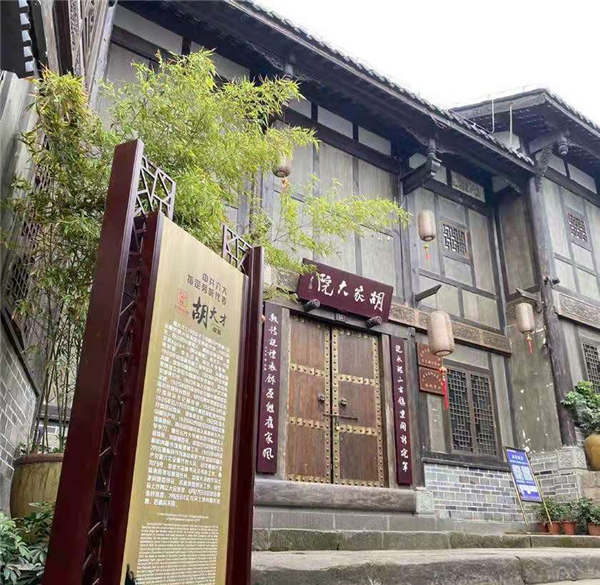Revolutionary spirit shines through rural rejuvenation
Inspired by the spirit of the revolutionaries of the older generation, people in Bazhong, Southwest China’s Sichuan province have been working hard to rejuvenate the old revolutionary base area.

The cemetery for the Red Army martyrs of the Sichuan-Shaanxi revolutionary base.
In recent years, Bazhong has been improving its infrastructural facilities and developing competitive industries. Local people have been striding towards an affluent society across all aspects.
The city's regional GDP has exceeded 10 billion yuan ($1.54 billion) for two consecutive years. The proportion of tertiary industry in its GDP increased by 2.7 percent to 50.9 percent. In the region you will find the Guangwu Mountain, the Nuoshui River World Geopark, and a 5A scenic spot, the Guangwu Mountain National Scenic Area. Bazhou, Nanjiang, Tongjiang and Pingchang have all become national demonstration counties for rural e-commerce.

Guangwu Mountain National Scenic Area
Tongjiang has been approved as a production base for its local specialty, white fungus, and a demonstration area for national organic product certification. Bazhou, Enyang, and Nanjiang have been identified as demonstration areas for provincial organic product certification.

A bird's-eye view of Enyang Ancient Town
Enyang and Tongjiang have been rewarded for their economic growth. Tongjiang and Pingchang have been listed among advanced counties for improving the income of farmers in Sichuan province.

Mansion of the Hu Family in Enyang
Approximately 499,000 poverty-stricken people have been lifted out of poverty, with 699 villages having shaken off poverty, and five counties having been removed from the list of poverty-stricken counties.
The land policy, promoting poverty-alleviation and urban-rural water supply integration, has been popularized throughout the country and province. Bazhong has been praised as an advanced city in poverty reduction by the Sichuan Provincial Committee of the Communist Party of China Sichuan and the provincial government for two consecutive years.
It boasts good-quality surface water, at or above Grade III in China's five-tier water quality system, and 100 percent of urban centralized drinking water sources are qualified.
Enyang and Pingchang have been listed as innovation bases for propagating the idea that lucid waters and lush mountains are as precious as mounds of silver and gold.
Nanjiang has been listed as the national demonstration county for ecological civilization construction. It has achieved "excellent" in the assessment of the Party and government in its production safety for three consecutive years.
The city's three-dimensional comprehensive transportation system is taking shape and expressways connect all of the counties in Bazhong. High-speed railways and air travel are available for local residents.
Four counties have been identified as national or provincial demonstration counties for high-quality rural roads.
As four reservoirs are listed in its national major water conservancy projects, Bazhong has become the main battlefield for water conservancy in the province. The urbanization of the city has been progressing, and the downtown area is now approximately 63.7 sq km, with 700,000 permanent residents, increasing the urbanization rate to 44.5 percent.
It was also selected as the national comprehensive standardization demonstration city for its rural revitalization, with 69 pastoral complexes of industrial parks, pastoral scenic spots, and new communities having been built.
Bazhong is also home to six advanced provincial villages and towns, including 51 demonstration villages for rural revitalization, and 64 provincial poverty-relief demonstration villages achieved through cultural approaches.
Enyang is listed as the national advanced county for a clean environment. The villages of Longwei and Shilong in Pingchang county, and Xixiang in Nanjiang county, are listed as beautiful leisure villages in China.
A 3.75-billion yuan fund was launched to revitalize the old revolutionary base area in Bazhong. In addition, a yellow goat trade center and the country’s only green pepper trade center have also been set up in the city. It has been listed in the national pilot cities for the reform of the rural collective property rights system.
It has established a national agricultural science and technology park, a municipal green agriculture innovation and development research institute, cultivated 39 national high-tech enterprises, and set up 23 municipal academician (expert) workstations.
The Bazhong-based Colorlink Co. was registered among the province’s first batch of gazelle enterprises and is the only gazelle enterprise in northeast Sichuan.
It hosted an agriculture fair and festivals for the arts, tea culture, and tourism, in order to attract investment and enrich people’s lives.
Approximately 65.45 billion yuan and 135 major industrial projects have been brought to the city. The import and export trade has also reached 2.95 billion yuan.
Bazhong has built and renovated 1.6 million sq m of campuses, with more than 84 percent of kindergartens being universally benefited. There are three provincial demonstration high schools and seven new tertiary hospitals.
More than 176,700 people were newly employed, with the registered unemployment rate dropping to 3.6 percent from the 4.4 percent seen at the end of the 12th Five-Year Plan period (2011-15).
The coverage of medical insurance and endowment insurance reached 98 percent and 96.2 percent respectively, and more than 5.25 billion yuan was allocated to support disadvantaged groups.
Bazhong is at the center and is the capital of China’s second largest Soviet area, the original Sichuan-Shaanxi Soviet Area, where red culture is still thriving. The older generation of proletarian revolutionaries, such as Xu Xiangqian and Li Xiannian, and 446 generals once fought there.
The practices in the old revolutionary base area combined the Communist Party of China’s thoughts on the agrarian revolution and real life struggles, and echoed the struggles in other Soviet areas. This dealt a heavy blow to the reactionary rule of the Kuomintang and lay a solid foundation for the Red Army and the strategic transfer of the Chinese revolution.

